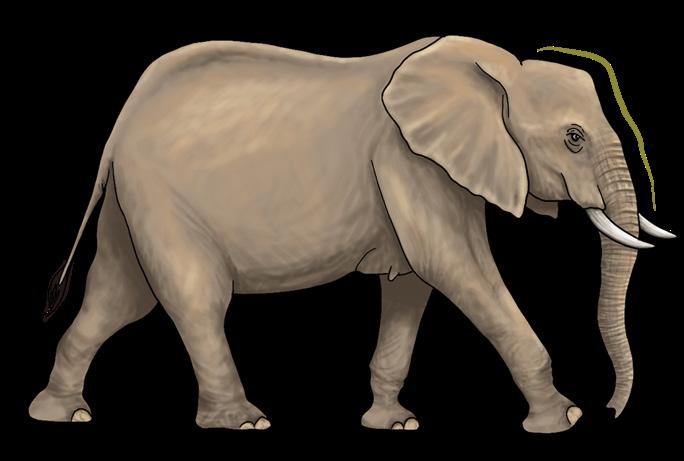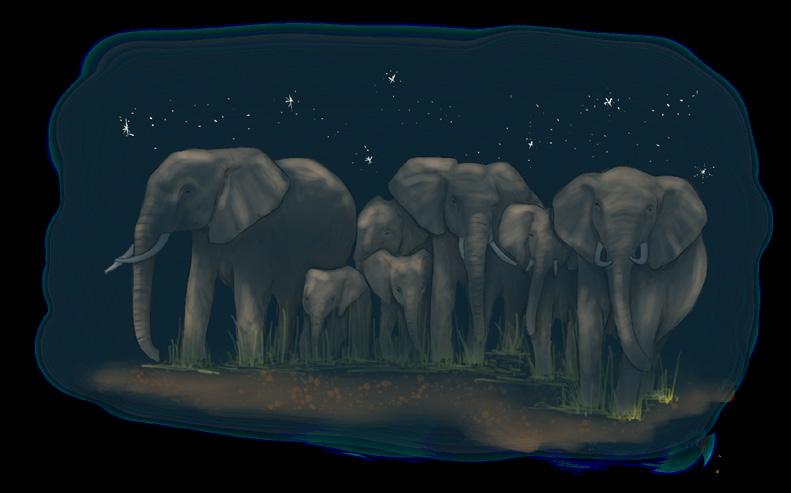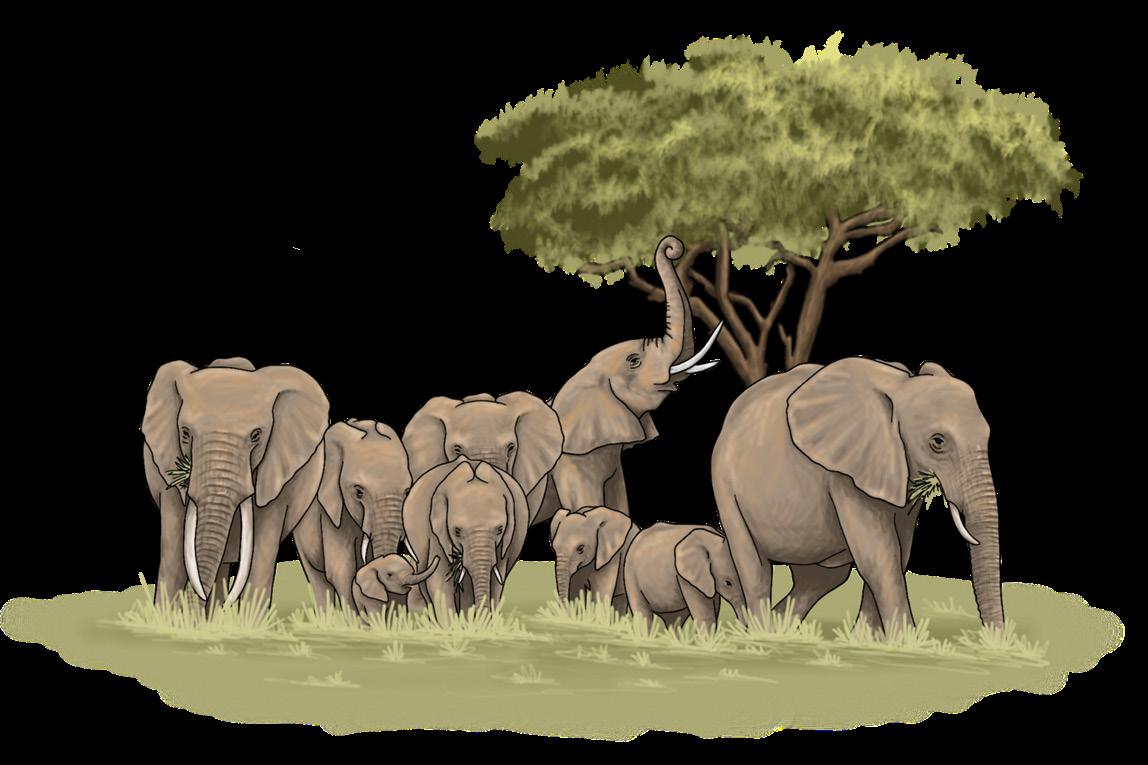Elephant Social Units, Reproduction & Memory







Elephants have excellent memories and are well known for their complex societies, family bonds and wide network of friendships. Social units are important as elephants depend on one another for protection and survival.
Social Units

Female Society/Cows
The basic family unit in a herd of elephants consists of a matriarch and all her female relatives (sisters, aunts and cousins) and their dependent offspring, totalling anywhere between 6 and 20 members.

Female elephants generally stay with their families for life, but this isn’t the case for males.
Due to the high level of responsibility it takes to raise each calf, older females ensure that every young elephant is raised with the utmost love, guidance, protection, support and care.
Occasionally, elephant mothers nurse calves that aren’t theirs. For instance, grandmothers may nurse their grandchildren to help their daughters.
Male Society/Bulls
Also known as bulls, male elephants reach maturity at about 10 to 13 years and soon after wander off from their family, where they often seek to befriend and join older herds of bachelor males.
Male elephants grow in height and weight during their teen years and continue growing through most of their adult lives Older males are larger and generally dominant to younger males.


Males have strict dominance hierarchies determined by each individuals physical strength, size and weight.
See ‘Introduction to Elephants’ document for physical differences between male and female elephants.
1.
In the wild, elephants can live up to an average of 60 years. Because they are such long-lived animals, they form strong social bonds and have lifelong friendships.

Despite having strong social bonds, family size and composition is fluid in nature. Sub-groups of females and their dependent calves may break off for hours, days, weeks or months at a time.
Males test their strength by play-fighting or pushing over objects like trees. When calves are learning to fight/play fight and they realize they are too small to fight each other, they may redirect their aggression and destroy a tree.
Families casually split up during severe droughts so they can avoid competing over scarce resources.





Females also have strict dominance hierarchies that are dictated by age and size. Knowing their place in a dominant hierarchy stops them from challenging the position of others, which prevents fighting and might be why female elephants are thought to be peaceful animals.
Older male elephants play an important role in the survival of younger males by passing on their skills and knowledge. Examples of inherited knowledge migration routes and when to show aggression.



 Collared Matriarch in Samburu National Reserve leading her family © Jane Wynyard/Save the Elephants.
Collared Matriarch in Samburu National Reserve leading her family © Jane Wynyard/Save the Elephants.
2.
Matriarchy
The matriarch is usually the oldest female and is responsible for making decisions and leading her family.
She plays a vital role in protecting her family fom danger.









When the family are under threat, the matriarch can coordinate defensive group responses. An example includes “bunching” - when the family bunch together and put the calves in the centre to protect them from predators (such as lions). “Bunching” is thought to be coordinated by the matriarch.

Older matriarchs are thought to make the best leaders because they have accumulated more experience and wisdom over the course of their long lives.
Due to this reason, matriarchs are able to lead their family to sufficient food and water sources during the dry periods, ensuring the young are well cared for, and providing protection when difficult situations arise.
Matriarchs have superior knowledge of threats and are better at knowing how to identify and respond to various threats. Example is discriminating between different threats posed by people, predators and even bees.
They also have superior social knowledge that helps her distinguish friends from unfamiliar elephants.


Losing a matriarch can lead to a loss of vital knowledge for the herd, such as historical water and food sources.

Many families split up soon after the death of a matriarch, which is probably related to conflict within the group over who should be the new leader.
Poachers often target the older matriarchs as she usually has the largest tusks- this is devastating for the family because of the loss of vital knowledge.


3.
Watch more on Female Leaders (The Elephant Queen Outreach)
Elephants have emotions
Elephants are highly social species and can recognise and respond to other elephants’ emotions.
Protective behaviour amongst elephants includes protection of the herd, comfort, babysitting, etc.
When a member of the herd is injured and cannot walk as fast as the rest of the herd, they will slow down to ensure that the injured elephant is not left behind.
Elephants have also been seen trying to help dying loved ones, lifting them with their trunks and tusks while calling out in distress.
They have been seen to show an interest in elephant carcasses and may return repeatedly to the carcass, to touch, sniff or manipulate it. Elephants also show a keen interest in the bones and ivory of other dead elephants.



African elephants become sexually mature between 10 to 12 years, whereas Asian elephants become sexually mature at about 14 years.

The gestation period elephant is approximately 22 months and they give birth to 1 calf after every to 4 years
Very rarely, they give birth to twins- but one has a higher chance of survival (the production of milk cannot sustain them both).
Elephant calves require lots of attention and guidance from their herds.
Baby elephants stay very close to their mothers for the first couple of months and suckle on their mother’s milk for at least 2 years, or until she gives birth to a new baby.
Watch how elephants mourn the death of other elephants: https://www.youtube.com/watch?v=MEvgkBdsQpw https://www.youtube.com/watch?v=Ku_GUNzXoeQ


Elephants have also been seen to assist in things like the removal of spears or veterinary darts from other elephants.
Elephants show affection to their friends, get angry and frustrated, and show signs of fear and distress.

Read more on Elephant communication | Sabi Sabi
Baby elephants suckle through their mouths as they have no control of their trunk muscles until about a year of age.
Baby elephants wean after 2-4 years. The mother will then give birth to a new baby.
Watch more videos on: Devoted mothers














Nursing
Education resources by The Elephant Queen
Reproduction
4.
Mating and Birthing
Mating in elephants occurs when the female is in estrus. Estrous is a period where female elephants are sexually receptive which lasts for about 3 weeks.



Females signal estrus via chemicals released from temporal glands on the sides of their face and throught their urine that is sniffed out by males.
Females ovulating display characteristic postures which include a particular way of walking (a strut)with their heads high producing low rumbling sounds to invite males to approach.
Watch mating behaviours on Elephant Voices
Most females prefer an older, larger, more dominant male to mate with. Sometimes, older females appear to help younger females decide who to mate with.
The dominant male wards off other males, and may put up a fight to show off his strength.
The Mating Ceremony then happens after a successful mating, where the family will come over to the newly mated couple and trumpet, rumble, sniff and touch the site.
After mating, the male will guard the female to prevent her from mating with any other bulls. This is called Guarding behaviour.
Elephant fathers in bringing up calves once it has been born. Once the mating ceremony happens, they leave to continue on their own.
There is limited scientific evidence to suggest that elephants prefer to give birth at night. It varies from herd to herd.


Some may prefer to give birth during the day when the rest of the herd is near to offer protection and security. Others may prefer to give birth in the cover of the night when it’s quiet.











Males enter a musth state which gives them a testosterone boost that helps them to fight off the competition and access estrus females.
Bulls in musth stream urine and secrete hormones from their temporal glands.
To learn more on Musth, see Elephant Aware Behaviour document.


Learn more on elephants mating
5.
Elephant herds are extremely protective when a mother elephant is giving birth.
In the wild, elephants typically prefer secluded areas with ample space and privacy to give birth.
The group forms a tight protective circle around the mother and they begin to thrust mud around.









They close any gaps between them to block the view from potential predators and they often vocalise loudly and frequently.
Occasionally, they may have given birth in areas with some human activities such as near villages. However, not indicative of a preference for elephants
If there is not enough of food and water inside parks, especially during dry seasons, elephants may move out of parks to seek for alternatives in farmlands.






This is especially when their natural habitat has been fragmented or corridors have been blocked.
Evidence suggests that elephant families do not slow down their movements after a baby is born. The newborn is able to keep up with the herd from day 1 (Taylor et al. 2022).
Watch more on Elephant birthing.
A newborn can be identified as they are often pink behind their ears, and are very hairy.
See Importance of Corridors for more information.
Do not approach a herd that is giving birth, even if they are close to your farm.
Do not try to chase a herd that is giving birth. This will make them more aggressive as they want to protect their new born.
They will eventually leave the area all together, once the newborn is on its feet.
6.
Memory and Home Range

Elephants are known to have incredible long-term memories that increase their chances of survival across changing landscapes.
They can remember migration routes they travelled as a calf and can re-visit the same water sources many years later.
They can discriminate between the different threats various people pose based on scents and sounds and older elephants pass this information down to the next generation. (McComb 2014 &
Why do elephants spend time outside protected areas?
Elephants areas and may end up accessing been built

Elephants also recall moments they experienced pain, such as bee stings from beehivefences (King et al., 2009) and shocks from electric fences. With just one negative encounter with various fences, elephants will remember and may avoid it for a long time.

Parks may not be enough to sustain large populations of elephants because of how much food they need to survive (100 to 400 kgs per day).

Elephants wander out of protected areas to look for and enjoy a wider variety of food types to feed on and stay healthy.
Increased infrastructure can cause elephants to wander into farmlands because roads and buildings block the routes they would otherwise use to cross the landscape, causing them to be


Credits and Disclaimer:









We have collected the information above from multiple sources that are sourced throughout thedocument. The main contributors are Elephant Voices and The Elephant Queen Outreach Project. Special thanks to Jemima Scrase for her input. This manual is not extensive. To learn andexplore more about Elephants, see References. Some of the original information used has been simplified for easy understanding.Save the Elephants advises caution with all the information collected and presented in this toolbox.Further research may be required before each site-specific implementation.



* Save the Elephants is not liable for any costs, damages or injuries incurred by the use of these methods or information.


Produced by Save the Elephants www.savetheelephants.org
Made in
2023
Illustrations by Nicola Heath
Kenya
It is important to protect your farms and compounds with effective barriers to deter elephants.
7.
“I remember visiting this water hole when I was young. This is the right way.”








 Collared Matriarch in Samburu National Reserve leading her family © Jane Wynyard/Save the Elephants.
Collared Matriarch in Samburu National Reserve leading her family © Jane Wynyard/Save the Elephants.


































